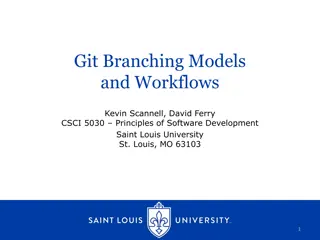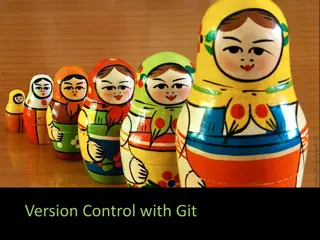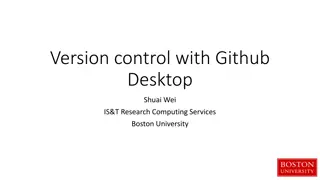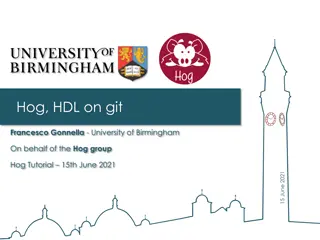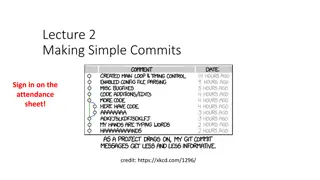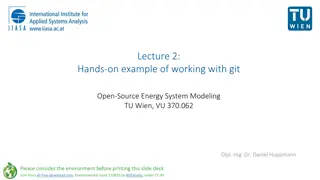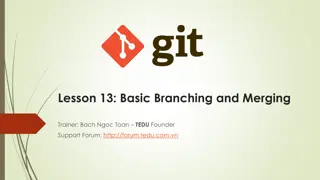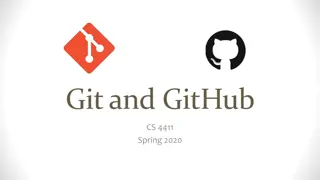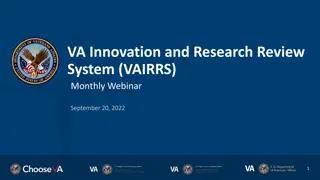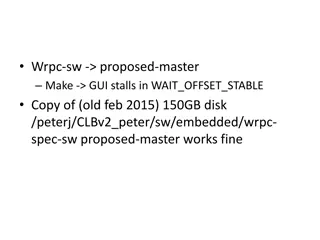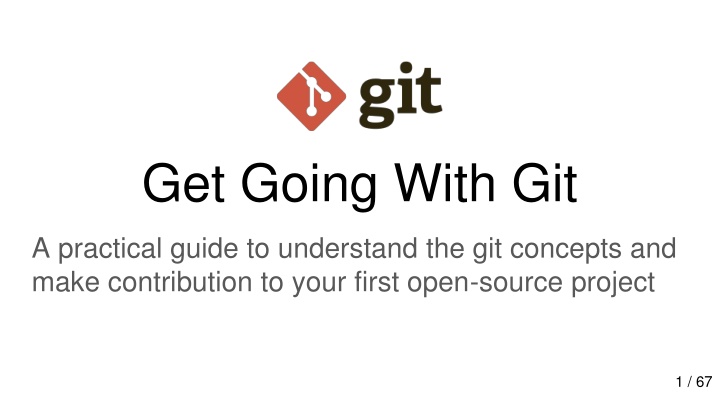
Git Concepts Demystified: A Practical Guide to Open-Source Contributions
Explore Git concepts, understand the workflow, and learn how to contribute to open-source projects effortlessly. This guide covers Git installation, basic commands, GitHub publishing, and more for seamless version control. Start your Git journey today!
Download Presentation

Please find below an Image/Link to download the presentation.
The content on the website is provided AS IS for your information and personal use only. It may not be sold, licensed, or shared on other websites without obtaining consent from the author. If you encounter any issues during the download, it is possible that the publisher has removed the file from their server.
You are allowed to download the files provided on this website for personal or commercial use, subject to the condition that they are used lawfully. All files are the property of their respective owners.
The content on the website is provided AS IS for your information and personal use only. It may not be sold, licensed, or shared on other websites without obtaining consent from the author.
E N D
Presentation Transcript
Get Going With Git A practical guide to understand the git concepts and make contribution to your first open-source project 1 / 67
About me Hello, everyone. Welcome to today's session. I am Divya Bhushan. I am a Technical Writer at Visual BI Solutions. I have 12+ years of IT experience in Linux/Unix Administration, Database Administration, and Technical Documentation. Apart from my job, I contribute to open source. I have contributed to Kubernetes and Water Monitoring System which is part of GirlScript Summer of Code, Rails Girls Summer of Code. Let s begin today s session.
Sigh of relief !!! It is developed to ease your task of maintaining, storing and tracking every version of your change. Git is not another programming language that you need to learn. Just concentrate on your project and let Git manage the rest for you. Never lose your work again ! Quickly undo and fix your mistakes :) 3 / 67
Objective - - - - - - - Git terminology Architecture How to Install, configure and use Git Get to know the basic commands Git workflow Publish on GitHub Contribute to an open-source project 4 / 67
Compare and create PR UPSTREAM ORIGIN git remote add upstream git fetch upstream git checkout master git rebase upstream/master git Yes git push git clone resolve conflicts No git rebase --continue GITHUB Local Repo HEAD git commit git add git checkout -b branch New Branch LOCAL 6 / 67
Prerequisites Basic knowledge of any Operating System Good to have a familiarity writing basic terminal commands Git version: 2.27.0 Create a GitHub account Text editor: Visual Studio Code(or any editor of your choice) Demo setup: Operating System: macOS Catalina Git version: 2.27.0 Visual Studio Code: 1.46.1 7 / 67
Course Modules Module 2: Install and Initialize git repo Module 3: Work locally with git Module 4: Branching and Merging Module 1: Introduction to Git Module 5: Collaboration 8 / 67
Module 1: Introduction To Git Module 2: Install and Initialize git repo Module 3: Work locally with git Module 4: Branching and Merging Module 1: Introduction to Git Module 5: Collaboration 9 / 67
Module 1: Introduction to Git Module 1: Introduction to Git Module 1: Introduction to Git Need for a (VCS) Types of VCS Merits of Git 10 / 67
Module 1.1: Need for a Version Control System Module 1: Introduction to Git Module 1: Introduction to Git Need for a (VCS) Types of VCS Merits of Git 11 / 67
1.1 What is a VCS and why do we need it A VCS (Version Control System) is a software to store, track, and share your data Few popular VCS like CVS, SVN, BitKeeper, ClearCase and Perforce were developed for the purpose of: Backup and restore (time travel) Track ownership Work in isolation (branching) Collaborate or merge your work with your peers using remote sharing Continuous Integration and development (deployment) of the code 12 / 67
Module 1.2: Types of VCS Module 1: Introduction to Git Module 1: Introduction to Git Need for a (VCS) Merits of Git Types of VCS 13 / 67
Centralized VCS Each developer s change must go into the main trunk before it can be seen by others 14 / 67
De-centralized or Distributed VCS In a Distributed VCS (DVCS) : - Each user has a personal copy of the entire repository. - Users choose when to publish the changes. - Users share work among each other. Git is a Distributed VCS 15 / 67
Module 1.3: Merits of Git Module 1: Introduction to Git Module 1: Introduction to Git Need for a (VCS) Types of VCS Merits of Git 16 / 67
1.3 Merits of Git - - - - - Distributed architecture Speed = Most of the operations are local (data store and data fetch) Data Integrity Easy branching and merging Collaboration 17 / 67
Summary: Module 1: Introduction to Git What we learnt so far? - - VCS is a software to store, manage and track data changes Git is a distributed VCS with its unique features such as distributed architecture, speed, data integrity, easy branching and merging and collaboration strategy. 18 / 67
Module 2: Install, Configure, and Initialize git repo Module 2: Install and Initialize git repo Module 3: Working locally with git Module 4: Branching and Merging Module 1: Introduction to Git Module 5: Collaboration Install Git Configure Initialize local repo 19 / 67
Module 2.1: Install Git Module 1: Introduction to Git Module 2: Install, Configure, and Initialize C Initialize a git repository Install Git onfigure 20 / 67
2.1: Install Git - Go to https://git-scm.com/downloads - - Download the Git software for your Operating System Go to terminal and check the git version installed: git version 21 / 67
Demo 22 / 67
Module 2.2: Configure Git Module 1: Introduction to Git Module 2: Install, Configure, and Initialize C Initialize a git repository Install Git onfigure 23 / 67
2.2: Git configurations #Set your github username git config --global user.name 'yourname' #Set your github email id git config --global user.email 'youremail@domain' #View the configuration settings git config --global list 24 / 67
Demo 25 / 67
Module 2.3: Initialize a git repository Module 1: Introduction to Git Module 2: Install, Configure, and Initialize C Initialize a git repository Install Git onfigure 26 / 67
2.3: Initialize a Git repository #Create a new project on your machine mkdir git-demo #Change directory to git-demo cd git-demo #Initialize a git repository git init . 27 / 67
Demo 28 / 67
Summary: Module 2: Install, Configure, and Initialize git repo What did we learn? - - - How to Install Git Set global configuration settings Create a new git repository 29 / 67
Module 3: Work locally with Git Module 2: Install and Initialize git repo Module 3: Work locally with git Module 4: Branching and Merging Module 1: Introduction to Git Module 5: Collaboration Git workflow & architecture Add/modify data Stage Commit 30 / 67
Module 3.1: Git workflow and architecture Module 1: Introduction to Git Module 3: Work locally with Git Git workflow and architecture Add/modify data Commit Stage 31 / 67
3.1: Git workflow and git architecture - The basic operations in any project: The 3-tier architecture - CRUD data functions: Create, Read, Update, Delete - Add to Staging Area - Commit to Local Repo 32 / 67
Explore the project file structure Git architecture resembles the filesystem of Linux OS. All of its database objects are stored as metadata in a hidden folder - .git. 33 / 67
Module 3.2: Add/modify data Module 1: Introduction to Git Module 3: Work locally with Git Git workflow and architecture Commit Add data Stage 34 / 67
Working Directory WORKING DIR STAGING AREA LOCAL REPO #!/bin/sh 35 / 67
Module 3.3: Stage Module 1: Introduction to Git Module 3: Work locally with Git Git workflow and architecture Commit Add data Stage 36 / 67
Staging Area WORKING DIR STAGING AREA LOCAL REPO #!/bin/sh #!/bin/sh git add 37 / 67
Module 3.4: Commit Module 1: Introduction to Git Module 3: Work locally with Git Git workflow and architecture Commit Add data Stage 38 / 67
Local Repository WORKING DIR STAGING AREA LOCAL REPO #!/bin/sh #!/bin/sh #!/bin/sh git add git commit 39 / 67
Module 3: Work locally with Git - Demo git local workflow screenshot Initialize a git repository and data. See how your file is created in Working Directory, staged to the Index, and moved to the Local Repository when you commit. Commands in a nutshell: git init . git add . git status git commit 40 / 67
Modify file in the Working directory WORKING DIR STAGING AREA LOCAL REPO #!/bin/sh main() { } #!/bin/sh #!/bin/sh 41 / 67
Add modified file to the Staging area WORKING DIR STAGING AREA LOCAL REPO #!/bin/sh main() { } #!/bin/sh main() { } #!/bin/sh git add 42 / 67
Commit the modified file to the Local repo WORKING DIR STAGING AREA LOCAL REPO #!/bin/sh main() { } #!/bin/sh main() { } #!/bin/sh main() { } git add git commit 43 / 67
Summary of git workflow commands Add new file echo #Readme file > README.md Stage the file git add . View the status git status Commit the snapshot git commit -m Initial commit View the log git log 44 / 67
Module 4: Branching and Merging Module 2: Install and Initialize git repo Module 3: Work locally with git Module 4: Branching and Merging Module 1: Introduction to Git Module 5: Collaboration What is a branch Create a branch Merge branches 45 / 67
Module 4.1: What is a Branch? Module 1: Introduction to Git Module 4: Branching and Merging What is a Branch? Merge the branch Create a Branch 46 / 67
Module 4.1: What is a Branch? - A branch is a parallel independent line of development A replica environment for your source code You create and work in branches to - Isolate your work to create a new feature or bug-fix - - 47 / 67
Module 4.2: Create a branch Visualize and learn here: https://git-school.github.io/visualizing-git/#free git commit git commit Git branch dev Git commit Git checkout dev Git commit Git commit Git branch feature 48 / 67 Git checkout feature
Module 4.2: Create a branch Visualize and learn here: https://git-school.github.io/visualizing-git/#free git commit git commit Git branch dev Git commit Git checkout dev Git commit Git commit Git branch feature 48 / 67 Git checkout feature


